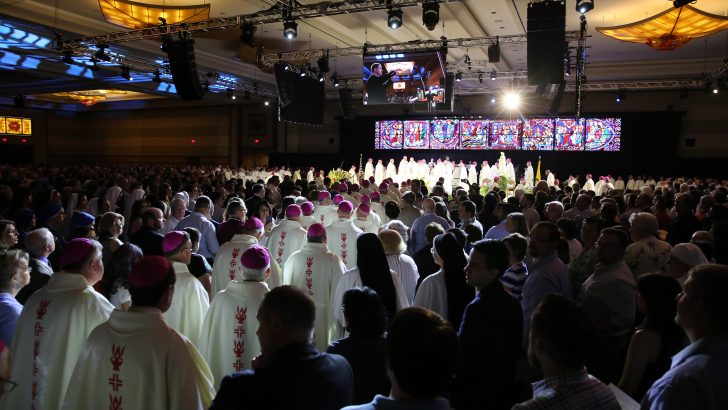Fr Jeffrey Kirby
Last weekend and at the start of this week, the Catholic community swarmed the city of Orlando. The US Bishops’ Conference called together approximately 3,000 leaders from every sector of the Church’s life in order to listen and talk about the surprising topic of evangelisation.
It might catch some folks off guard to hear that the Catholic Church called together this unprecedented convocation to discuss evangelisation. For many people in the US, ‘evangelisation’ isn’t really a Catholic word. It’s not one that’s usually associated with the Catholic way of life. And so, what was going on in Orlando?
Well, some history might help. Evangelisation is actually a very Catholic concept. Much of the Church’s history is filled with lively moments of sharing the Gospel with others.
Regrettably, over more modern times, the Church went on lockdown mode. Times were changing and Church leadership, for many reasons, chose not to dialogue, engage, or appropriately change with them.
The Church created silos, stayed in its ghettos, in its trenches, and was viewed as an irrelevant museum. Perhaps nice to have around for ceremonies and nostalgia but not seen as a real contributor or help to humanity, its ills, or its contemporary questions.
Groups
In this state of affairs, an esoteric approach was the Catholic rule of the day. The generous, vulnerable, and dirty work of sharing the Good News of Jesus Christ fell by the wayside. It wasn’t completely gone as some areas in the world and some groups within the Church singled themselves out for their efforts to evangelise. But in general the work of evangelisation appeared to go on hiatus in the Catholic Church.
The Great Commission of the Lord Jesus, “Go, teach all nations…” seemed to be overshadowed by a reactionary precept, “Stay here, and don’t talk to anyone that’s not like us…”
This was the popular landscape in the Catholic world until the Solemnity of the Conversion of St Paul, January 25, 1959. On that day, Pope St John XXIII concluded the Octave of the Chair of Christian Unity with Evening Prayer at the Basilica of St Paul’s Outside-the-Walls in Rome. In the Pope’s remarks on that day, and to the shock of almost everyone, it was announced that an ecumenical council was going to be convened.
No one would have anticipated such a thing since such universal councils were only called when the Church was in severe theological conflict. In the Church’s entire history up to that point, there had only been 20 such councils. The last one had been about 400 years before and was brought together because of the Reformation.
And so, “good Pope John” explained that the “prophets of doom” needed to go away and it was time for some aggiornamento, that is, some internal renewal both in how the Church saw itself and in how it understood and presented the Gospel to the world. The cheerful Pontiff was calling for an end to the hiatus on evangelisation. He saw the world hurting and in need of accompaniment and so he summoned the entire Church back to the Great Commission.
In its work, the Second Vatican Council reinvigorated the leaven of the Gospel in the life of the Church and extensive outreaches and overtures of friendship were initiated. The Catholic Church rejoined humanity’s conversation and proposed the Gospel message as a solace, support and inspiration to the sufferings and sorrows of life.
It sought to listen, learn and to speak ‘the truth in love’. The Catholic Church was creatively retrieving its witness in the world and evangelisation, expressed in so many diverse ways, was reborn and unleashed in the life of the Catholic Church and its members.
But then came the navel gazing. Although evangelisation documents were still being released and papal visits were being made, the enthusiasm for evangelisation waned. In its place came intense introspection, bickering, presumption of malign intentions over endeavours by various Church leadership, and general confusion. Evangelisation was stuck in a paralysis by analysis.
But then came March 13, 2013. On that day, once again the world was surprised as the Catholic Church received its first Latin American Pope. Taking the name Francis, the new Pontiff immediately sought to reignite the momentum for evangelisation. Unlike previous efforts to exclusively evangelise through culture (which oftentimes led to ‘culture wars’), Pope Francis introduced a new effort popularly called ‘evangelisation through the peripheries’.
Rather than engage the academy, debate politicians, fight with entertainment leaders, and such things, the new Pope chose to circumvent it all and go directly to those who are suffering, rejected, and ostracised. The Pope is calling the Church back to a poverty of spirit and to its vocation as a ‘field hospital’ in the world today.
It’s not that the other work in culture doesn’t have a place. It must be done by some. But this Pope isn’t as interested in that method of evangelisation as he is intensely focused on the poor and forgotten. As he has said repeatedly in different ways: “Let this service be our message.”
Exhortation
The Pope’s first exhortation to the Church and the world was rightly entitled The Joy of the Gospel, and in the pages of Evangelii Gaudium are disclosed the spirit and heartfelt directions of Pope Francis to all believers to go to the peripheries and share the Good News.
In many respects, therefore, Pope St John XXIII’s actions were prophetic in convening the Second Vatican Council and opening up some windows and calling the Church out of its bastions and back into the world.
Pope Francis is continuing this work and in Orlando this week, Catholic leaders were praying, listening and sharing, studying The Joy of the Gospel, and asking how we can all go to the peripheries and fulfil in today’s world the Great Commission given to us by Jesus Christ.
Fr Jeff Kirby is a member of the Bishop of Charleston’s delegation to the Convocation of Catholic Leaders in Orlando.



